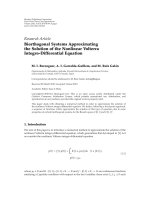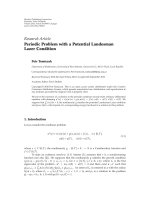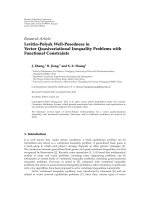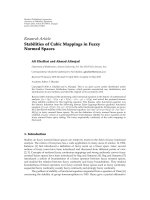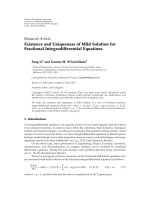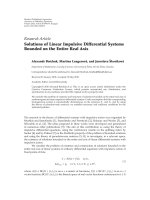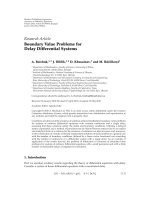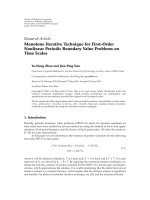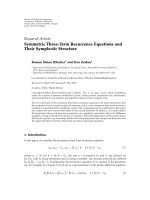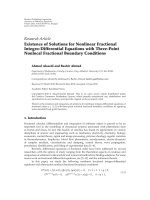Báo cáo sinh học: " Research Article Periodic Systems Dependent on Parameters" potx
Bạn đang xem bản rút gọn của tài liệu. Xem và tải ngay bản đầy đủ của tài liệu tại đây (531.15 KB, 17 trang )
Hindawi Publishing Corporation
Journal of Inequalities and Applications
Volume 2010, Article ID 796165, 17 pages
doi:10.1155/2010/796165
Research Article
Periodic Systems Dependent on Parameters
Min He
Department of Mathematical Sciences, Kent State University at Trumbull, Warren, OH 44483, USA
Correspondence should be addressed to Min He,
Received 1 January 2010; Revised 5 March 2010; Accepted 14 March 2010
Academic Editor: Shusen Ding
Copyright q 2010 Min He. This is an open access article distributed under the Creative Commons
Attribution License, which permits unrestricted use, distribution, and reproduction in any
medium, provided the original work is properly cited.
This paper is concerned with a periodic system dependent on parameter. We study differentiability
with respect to parameters of the periodic solution of the system. Applying a fixed point theorem
and the results regarding parameters for C
0
-semigroups, we obtained some convenient conditions
for determining differentiability with parameters of the periodic solution. The paper is concluded
with an application of the obtained results to a periodic boundary value problem.
1. Introduction
One of the fundamental subjects in dynamic systems is the boundary value problem. When
studying boundary value problems of differential and integrodifferential equations, we often
encounter the problems involving parameters. Take, for example, a periodic boundary value
problem
u
t
u
xx
, for t ≥ 0,
u
x, 0
u
0
x
, for x ∈
0, 1
,
k
1
u
0,t
− h
1
u
x
0,t
f
1
t
,k
i
,h
i
≥ 0
i 1, 2
,
k
2
u
t
1,t
h
2
u
x
1,t
f
2
t
,k
i
h
i
> 0
i 1, 2
,
1.1
on the Banach space L
2
0, 1, where f
1
t and f
2
t are both ρ-periodic and continuously
differentiable. It appears that the boundary conditions contain four scalars k
1
,k
2
,h
1
, and h
2
.
Because these scalars may vary as the environment of the system changes, they are considered
2 Journal of Inequalities and Applications
as parameters. Reforming 1.1for details, see Section 5, we have the periodic boundary
value problem
w
t
w
xx
F
t, ε
,ε
k
1
,k
2
,h
1
,h
2
∈ R
4
, for t ≥ 0,
w
x, 0
w
0
x
, for x ∈
0, 1
,
k
1
w
0,t
− h
1
w
x
0,t
0,
k
2
w
1,t
h
2
w
x
1,t
0,
1.2
where Ft, εx1/k
1
k
2
h
2
k
2
h
1
k
1
f
2
t−k
2
f
1
txh
2
k
2
f
1
th
1
f
2
t. Clearly
Ft, ε is ρ-periodic.
Furthermore, when 1.2 is written as a matrix equation for details, see Section 5,its
associated abstract Cauchy problem has the following form:
dz
t
dt
A
ε
z
t
f
t, z
t
,ε
,
z
0
z
0
.
1.3
This example motivates the discussion on the parameter properties of the general
abstract periodic Cauchy Problem 1.3. Since the periodic system 1.3 depends on
parameters, it is a natural need for investigating continuity and differentiability with respect
to parameters of the solution of the system. Moreover, in applications, the differentiability
with respect to parameter is often a typical and necessary condition for studying problems
such as bifurcation and inverse problem 1. It is worth mentioning that 1.1 indicates that
the occurrence of parameters in the boundary conditions leads to the dependence of the
domain of the operator Aε on the parameters. We have developed some effective methods
for dealing with this tricky phenomenon.
In our previous work 2, we have obtained results on continuity in parameters of
1.3. In this paper, we will discuss the differentiability with respect to parameters of solutions
of 1.3.
According to the semigroup theory, when Aε generates a C
0
-semigroup Tt, ε,the
weak solution of 1.3 can be expressed in terms of the C
0
-semigroup Tt, ε:
z
t, ε
T
t, ε
z
0
t
0
T
t − s, ε
F
s, z
s, ε
,ε
ds. 1.4
It is clear that the differentiability with respect to parameter ε of semigroup Tt, ε will
be the key for determining the differentiability with respect to parameter ε of the solution
zt, ε of 1.3. Some recent works 3, 4, and reference therein have obtained fundamental
results on the differentiability with respect to parameters of C
0
-semigroup. Applying these
results together with some fixed point theorem, we are able to prove that 1.3 has a unique
periodic solution, which is continuously Frech
´
et differentiable with respect to parameter ε.
We now give the outline of the approaches and contents of the paper. The general
approach is that we first prove some theorems for the general periodic system 1.3 . Then,
by applying these results, we derive a theorem concerning 1.2 and thereby we obtain
Journal of Inequalities and Applications 3
differentiability with respect to the parameter ε of the solution of 1.1. The paper begins with
the preliminary section, which presents some differentiability results, a fixed point theorem,
and related theorems. These results will be used in proving our theorems in later sections. In
order to obtain results for 1.3, we, in Section 3, first study a special case of 1.3
z
A
ε
z f
t, ε
,
z
0
z
0
,
1.5
where ft ρ, εft, ε for some ρ>0, and ft, ε is continuous in t, ε ∈ R × P.
After obtaining the differentiability results for 1.5, we, in Section 4, employ a fixed point
theorem to attain the differentiability results of 1.3.Lastly,inSection 5, we will apply the
obtained abstract results to the periodic boundary value problem 1.1 and use this example
to illustrate the obtained results. One will see that the assumptions of the abstract theorems
are just natural properties of 1.1.
2. Preliminaries
In this section, we state some existing theorems that will be used in later proofs. We start by
giving the results on differentiability with respect to parameters.
Consider the abstract Cauchy problem 1.3, where Aε is a closed linear operator
on a Banach space X, · and ε ∈ P is a multiparameter P is an open subset of a finite-
dimensional normed linear space P with norm |·|.LetTt, ε be the C
0
-semigroup generated
by the operator Aε. For further information on C
0
-semigroup, see 5.
In 3, we obtained a general theorem on differentiability with respect to the parameter
ε of C
0
-semigroup Tt, ε on the entire space X. It is noticed that a major assumption of
the theorem is that the resolvent λI −Aε
−1
is continuously Frech
´
et differentiable with
respect to ε. In a recent paper, Grimmer and He 4 have developed several ways to determine
differentiability with respect to parameter ε of λI −Aε
−1
. Here, we include one of such
theorems for reference.
Assumption Q. Let ε
0
∈ P be given. Then for each ε ∈ P there exist bounded operators
Q
1
ε,Q
2
ε : X → X with bounded inverses Q
−1
1
ε and Q
−1
2
ε, such that Aε
Q
1
εAε
0
Q
2
ε.
Note that if Aε
1
Q
1
ε
1
Aε
0
Q
2
ε
1
, then
A
ε
Q
1
ε
A
ε
0
Q
2
ε
Q
1
ε
Q
−1
1
ε
1
Q
1
ε
1
A
ε
0
Q
2
ε
1
Q
−1
2
ε
1
Q
2
ε
Q
1
ε
A
ε
1
Q
2
ε
.
2.1
Thus, having such a relationship for some ε
0
implies a similar relationship at any
other ε
1
∈ P . Without loss of generality then, we may just consider the differentiating of
the semigroup Tt, ε at ε ε
0
∈ P.
Define RελλI − Aε
0
−1
I − Q
−1
1
εQ
−1
2
ε,forλ ∈ ρAε
0
∩ ρAε,and
assume that I − Rε : X → DAε
0
is invertible.
4 Journal of Inequalities and Applications
Theorem 2.1 see 3. Assume Assumption Q and that
1 there are constants M ≥ 1 and ω ∈ R such that
λI − A
ε
−1
≤
M
λ − ω
, for λ>ω,n∈ N, and all ε ∈ P. 2.2
2 There is K
1
> 0 such that Q
−1
2
εx
X
≤ K
1
x
X
, for all ε ∈ P.
3 There is K
2
> 0 such that I − Rε
−1
x
X
≤ K
2
x
X
, for all ε ∈ P.
4 For each x ∈ X, Q
−1
i
εx i 1, 2 and I − Rε
−1
x are (Frech
´
et) differentiable with
respect to ε at ε ε
0
.
Then for each x ∈ X, λI − Aε
−1
x is (Frech
´
et) differentiable with respect to ε at ε ε
0
.
Theorem 2.2 see 3. Assume the following
1 For some 0 <δ<π/2,ρAε ⊃
δ
{λ : |arg λ| <π/2 δ}∪{0}, for all ε ∈ P.
2 For each ε ∈ P , there exists a constant Mε such that
λI − A
−1
≤
M
ε
|
λ
|
for λ ∈
δ
,λ
/
0. 2.3
3 for each x ∈ X and each λ ∈
δ
\{0}, λI −Aε
−1
x is continuously (Frech
´
et)
differentiable with respect to ε on P. Moreover, for any ε
0
∈ P , there exists some ball
centered at ε
0
,sayBε
0
,δ
0
, δ
0
> 0 such that ε ∈ Bε
0
,δ
0
implies
D
ε
λI − A
ε
−1
x
≤ η
λ, x
, 2.4
where ηλ, x,λ∈ Γ, is measurable and for t>0
Γ
e
λt
η
λ, x
|
dλ
|
< ∞.
2.5
Then for each x ∈ X, Tt, εx is continuously (Frech
´
et) differentiable with respect to ε on P for t>0.
In particular, for t>0
D
ε
T
t, ε
x
1
2πi
Γ
e
λt
D
ε
λI − A
ε
−1
x
dλ,
2.6
where Γ is a smooth curve in
δ
running from ∞e
−iθ
to ∞e
iθ
for some θ, π/2 <θ<π/2 δ.
Now we state a fixed point theorem from 6.
Journal of Inequalities and Applications 5
Definition 2.3 see 6, page 6. Suppose that F is a subset of a Banach space X, |·|, G is a
subset of a Banach space Y,and{T
y
,y ∈G}is a family of operators taking F→X.The
operator T
y
is said to be a uniform contraction on F if T
y
: F→Fand there is a λ, 0 ≤ λ<1
such that
T
y
x − T
y
x
≤ λ
|
x −
x
|
∀y in G,x,x in F. 2.7
Theorem 2.4 see 6, page 7. If F is a closed subset of a Banach space X, G is a subset of a Banach
space Y, T
y
: F→F,y in G is a uniform contraction on F, and T
y
x is continuous in y for each
fixed x in F, then the unique fixed point gy of T
y
,y in G, is continuous in y. Furthermore, if F, G
are the closures of open sets F
◦
, G
◦
and T
y
x has continuous first derivatives Ax, y,Bx, y in y, x,
respectively, for x ∈F
◦
,y ∈G
◦
,thengy has a continuous first derivative with respect to y in G
◦
.
Theorem 2.5 see 7, page 167. Let f be a continuous mapping of an open subset Ω of E into F.
f is continuously (Frech
´
et) differentiable in Ω if and only if f is (Frech
´
et) differentiable at each point
with respect to the ith (i 1, 2, ,n) variable, and the mapping x
1
, ,x
n
→ D
i
fx
1
, ,x
n
(of
Ω into BE
i
,F) is continuous in Ω. Then at each point x
1
, ,x
n
of Ω, the derivative of f is given
by
Df
x
1
, ,x
n
·
t
1
, ,t
n
n
i1
D
i
f
x
1
, ,x
n
· t
i
,
t
1
, ,t
n
∈ E. 2.8
Theorem 2.6 see 4. Let X, ·
X
and Y, ·
Y
be Banach spaces, and let {Bε}
ε∈P
⊂
BX, Y. Assume that
A for each x ∈ X, Bεx is continuously (Frech
´
et) differentiable in P. In particular, for ε
0
∈ P,
D
ε
Bεx|
εε
0
∈BP,Y is the (Frech
´
et) derivative of Bεx at ε ε
0
, and D
ε
Bεx is
continuous in P.
Then, for each ε
0
∈ P, there is a constant Hε
0
> 0 such that
D
ε
B
ε
x|
εε
0
h
Y
≤ H
ε
0
x
X
·
|
h
|
for x ∈ X, h ∈P.
2.9
Lemma 2.7. Let B ∈BX, Y .IfB≤1/2,thenI − B
−1
exists, and
I − B
−1
∞
k0
B
k
.
2.10
Moreover, I − B
−1
≤2.
Proof. The proof is standard and is omitted here.
3. Differentiability Results of 1.5
In this section, we study 1.5, which is a special case of 1.3. We will prove that the uniques
periodic solution of 1.5 is continuously Frech
´
et differentiable with respect to parameter ε.
6 Journal of Inequalities and Applications
We first state a theorem from 2. This result shows that 1.5 has a unique periodic solution
which is continuous in parameter ε.
Theorem 3.1 see 2. Assume that
1 Tt, εz is continuous in ε for each z ∈ X, and
T
t, ε
≤ M
t
0
3.1
for some Mt
0
> 0 and all ε ∈ P, t ∈ 0,t
0
, and
2 TNρ,ε≤k<1 for some integer N with Nρ < t
0
and all ε ∈ P.
Then there exists a unique ρ-periodic solution of 1.5,sayzt, ε, which is continuous in ε for ε ∈ P .
Nowwewilldiscussdifferentiability with respect to parameter ε of the periodic
solution of 1.5. The following lemma presents a general result on the differentiability with
respect to parameter of the fixed point of a parameter dependent operator.
Lemma 3.2. Let Kε ∈BX for each ε ∈ P, and let zε be the fixed point of Kε for each
ε ∈ P , which is continuous in ε. Also, let Qz, εKεz.IfQz, ε has the first partial derivatives
D
z
Qz, ε and D
ε
Qz, ε which satisfy
1 D
z
zε,εx is continuous in ε for each x ∈ X and D
z
Qz, ε≤α<1 for all z, ε ∈
X × P , and
2 D
ε
Qz, ε is continuous in z, ε ∈ X × P ,
then zε is continuously (Frech
´
et) differentiable with respect to ε ∈ P.
Proof. We begin by noting that the equation
y D
z
Q
z
ε
,ε
y D
ε
Q
z
ε
,ε
h, h ∈P, 3.2
has a unique solution, say yε, h, which is linear in h.
It follows from Lemma 3.21 and Theorem 2.4 that
y
ε, h
I − D
z
Q
z
ε
,ε
−1
D
ε
Q
z
ε
,ε
h
3.3
is the unique solution of 3.2 for ε, h ∈ P ×P, which is continuous in ε, h.
From the uniqueness, one observes that
y
ε, αh
1
βh
2
αy
ε, h
1
βy
ε, h
2
, 3.4
for all scalars α, β and h
1
,h
2
∈P.Thatis,yε, h is linear in h and may be written as Cεh,
where Cε : P→X is a bounded linear operator for each ε ∈ P .
Now we show that Cε is the derivative of zε.
Journal of Inequalities and Applications 7
Let w zε h − zε − Cεh. Since zεQzε,ε by hypothesis, one sees that
w Q
z
ε h
,ε h
− Q
z
ε
,ε
− C
ε
h
Q
z
ε h
,ε h
− Q
z
ε h
,ε
Q
z
ε h
,ε
− Q
z
ε
,ε
− C
ε
h
D
ε
Q
z
ε h
,ε
h ◦
h
D
z
Q
z
ε
,ε
z
ε h
− z
ε
◦
z
ε h
− z
ε
− C
ε
h.
3.5
Note that there is a function kε, h continuous in h and approaching zero as h → 0
such that
◦
z
ε h
− z
ε
k
ε, h
z
ε h
− z
ε
. 3.6
Now from 3.5 and since Cεh is a solution of 3.2
, we have
w D
ε
Q
z
ε h
,ε
h ◦
h
D
z
Q
z
ε
,ε
z
ε h
− z
ε
k
ε, h
z
ε h
− z
ε
− C
ε
h
D
ε
Q
z
ε h
,ε
− D
ε
Q
z
ε
,ε
h ◦
h
D
z
Q
z
ε
,ε
k
ε, h
w k
ε, h
C
ε
h.
3.7
Thus
I − D
z
Q
z
ε
,ε
− k
ε, h
w
D
ε
Q
z
ε h
,ε
− D
ε
Q
z
ε
,ε
h ◦
h
k
ε, h
C
ε
h.
3.8
Since D
ε
Qzε,ε and zε are continuous, and {p ∈P| |p| 1} is compact, the right-
hand side of this expression is ◦|h| as |h|→0. Also, there is a γ
0
> 0 such that D
z
Qzε,ε
kε, h≤β<1for|h|≤γ
0
,soI − D
z
Qzε,ε − kε, h
−1
is bounded. Thus |w| ◦|h| as
|h|→0.
Remark 3.3. This proof is based on that of Theorem 3.2from6, page 7.
Now we prove the main theorem of the section.
Theorem 3.4. Assume that
1 Tρ, ε≤α<1 for all ε ∈ P.
2 Tt, εz is continuously (Frech
´
et) differentiable with respect to ε for each z ∈ X. Moreover
for any ε
0
∈ P thereissomeδε
0
> 0 such that ε ∈ Bε
0
,δε
0
D
ε
T
t, ε
z
≤ H
ε
0
z
for some
H
ε
0
> 0,t∈
0,ρ
.
3.9
3 ft, ε is continuously (Frech
´
et) differentiable with respect to ε.
8 Journal of Inequalities and Applications
Then there exists a unique ρ-periodic solution of 1.5,sayzt, ε, which is continuously (Frech
´
et)
differentiable with respect to ε for ε ∈ P .
Proof. First note that from Theorem 3.1, we have that
z
t, ε
T
t, ε
z
0
ε
t
0
T
t − s, ε
f
s, ε
ds
3.10
is the unique ρ-periodic solution of 1.5.
Nowwewanttoshowthatz
0
ε is continuously Frech
´
et differentiable with respect
to ε by applying Lemma 3.2. To this end, we need to prove the following two claims first.
Claim 1. Tt −s,εfs, ε is continuously Frech
´
et differentiable with respect to ε for t −s, s ∈
0,ρ. In particular, for any ε
0
∈ P,
D
ε
T
t − s, ε
f
s, ε
εε
0
D
ε
T
t − s, ε
f
s, ε
0
εε
0
T
t − s, ε
0
D
ε
f
s, ε
εε
0
.
3.11
In fact, for any ε
0
∈ P and h ∈Pwith ε
0
h ∈ P,
1
|
h
|
T
t − s, ε
0
h
f
s, ε
0
h
− T
t − s, ε
0
f
s, ε
0
−
D
ε
T
t − s, ε
f
s, ε
0
εε
0
T
t − s, ε
0
D
ε
f
s, ε
εε
0
h
≤
1
|
h
|
T
t − s, ε
0
h
f
s, ε
0
h
− f
s, ε
0
−
D
ε
f
s, ε
εε
0
h
1
|
h
|
T
t − s, ε
0
h
f
s, ε
0
− T
t − s, ε
0
f
s, ε
0
−
D
ε
T
t − s, ε
f
s, ε
0
εε
0
h
1
|
h
|
{
T
t − s, ε
0
h
− T
s, ε
0
}
D
ε
f
s, ε
εε
0
h
.
3.12
The first two terms on the right go to 0 as |h|→0byTheorem 3.42 and 3 . The last term on
the right goes to 0 because Tt−s, εz is continuous at ε
0
and the set {D
ε
fs, ε|
εε
0
p ||p| 1}
is compact, so 3.11 holds.
Now for each fixed t and s,andanyε
0
∈ P,andε ∈ Bε
0
,δε
0
,fromTheorem 3.42-
3 and 3.11, it is clear that D
ε
Tt−s, εfs, ε is continuous at ε
0
. This completes the proof
of Claim 1.
Based on Claim 1, we have the following claim.
Claim 2. D
ε
ρ
0
Tρ − s, εfs, εds
ρ
0
D
ε
Tρ − s, εfs, εds.
In fact, from Theorem 2.5 it suffices to show that
D
ε
i
ρ
0
T
ρ − s, ε
f
s, ε
ds
ρ
0
D
ε
i
T
ρ − s, ε
f
s, ε
ds
i 1, ,n
.
3.13
Journal of Inequalities and Applications 9
W.l.o.g. assume that P R
n
.Letε
0
ε
0
i
, ,ε
0
n
be any point in P . Since fs, ε is
continuous on 0,ρ ×
Bε
0
,δε
0
, there exists L>0 such that
f
s, ε
≤ L for
s, ε
∈
0,ρ
×
B
ε
0
,δ
ε
0
.
3.14
Now from 3.9, we have
ε
i
ε
0
i
ρ
0
D
ε
i
T
ρ − s, τ
f
s, τ
ds dτ
τ
ε
1
, ,τ, ,ε
n
≤
ε
i
ε
0
i
ρ
0
D
ε
T
ρ − s, τ
·
f
s,
τ
ds dτ ≤
ε
i
ε
0
i
ρ
0
L · H
ε
0
ds dτ < ∞.
3.15
Thusbyatheoremfrom8, page 86, we have
ε
i
ε
0
i
ρ
0
D
ε
i
T
ρ − s, τ
f
s, τ
ds dτ
ρ
0
ε
i
ε
0
i
D
ε
i
T
ρ − s, τ
f
s, τ
dτ ds.
3.16
Furthermore,
D
ε
i
ε
i
ε
0
i
ρ
0
e
λt
D
ε
i
λI − A
τ
−1
xdλdτ D
ε
i
ρ
0
ε
i
ε
0
i
e
λt
D
ε
i
λI − A
τ
−1
xdτdλ.
3.17
Now the left-hand side of 3.17 is
D
ε
i
ε
i
ε
0
i
ρ
0
e
λt
D
ε
i
λI − A
τ
−1
xdλdτ
ρ
0
e
λt
D
ε
i
λI − A
ε
−1
xdλ,
3.18
and the right-hand side of 3.17 is
D
ε
i
ρ
0
ε
i
ε
0
i
e
λt
D
ε
i
λI − A
τ
−1
xdτdλ D
ε
i
ρ
0
e
λt
λI − A
ε
−1
x −
λI − A
ε
0
−1
x
dλ
D
ε
i
ρ
0
e
λt
λI − A
ε
−1
xdλ,
3.19
where ε
0
ε
1
, ,ε
i−1
,ε
0
i
,ε
i1
, ,ε
n
.
That is,
D
ε
i
ρ
0
e
λt
λI − A
ε
−1
xdλ
ρ
0
e
λt
D
ε
i
λI − A
ε
−1
xdλ.
3.20
This completes the proof of Claim 2.
10 Journal of Inequalities and Applications
Next, consider the operator
K
ε
z T
ρ, ε
z
ρ
0
T
ρ − s, ε
F
s, ε
ds.
3.21
We will apply Lemma 3.2 and Claims 1-2 to show that the operator Kε has z
0
ε as the fixed
point and z
0
ε is continuously Frech
´
et differentiable with respect to ε.
Note that the operator Kε has the following properties.
i Kε is defined on the Banach space X, ·.
ii Kε is a uniform contraction on X.
In fact, for all ε ∈ P and z
1
,z
2
∈ X,
K
ε
z
1
− K
ε
z
2
T
ρ, ε
z
1
− z
2
≤
T
ρ, ε
·
z
1
− z
2
≤ α
z
1
− z
2
since
T
ρ, ε
≤ α<1
.
3.22
iii Kεz is continuous in ε for each fixed z ∈ X. For the detailed proof, see Theorem
3.2from2.
Applying Theorem 2.4, we have that z
0
ε is the fixed point of Kε.
Furthermore, it is clear that the first derivative of Kεz with respect to z
D
z
K
ε
z T
ρ, ε
3.23
satisfies Lemma 3.21 . It is also clear from Claim 2 that the first derivative of Kεz with
respect to ε
D
ε
K
ε
z
D
ε
T
ρ, ε
z
ρ
0
D
ε
T
ρ − s, ε
f
s, ε
ds
3.24
is continuous in z, ε by Theorem 3.42 and 3. Note that using the same argument as
in the proof of Claim 1, we can show that D
ε
Tρ − s, εfs, ε is continuous at ε ε
0
and
thereby
ρ
0
D
ε
Tρ − s, εfs, εds is continuous at ε
0
.
Finally applying Lemma 3.2, we have that z
0
ε is continuously Frech
´
et differen-
tiable with respect to ε. Using a similar argument as that in Claim 1 and Claim 2 we can
show that Tρ, εz
0
ε and
t
0
Tρ−s, εfs, εds are continuously Frech
´
et differentiable with
respect to ε.Thus,
z
t, ε
T
t, ε
z
0
ε
t
0
T
t − s, ε
f
s, ε
ds
3.25
is continuously Frech
´
et differentiable with respect to ε for ε ∈ P.
Now we present a theorem with an assumption on the resolvent of the operator Aε
instead of the C
0
-semigroup Tt, ε.
Journal of Inequalities and Applications 11
Theorem 3.5. Assume Theorem 3.4(1) and (3) and that
1 for some 0 <δ<π/2,ρAε ⊃
δ
{λ : |arg λ| <π/2 δ}∪{0} for all ε ∈ P,
2 there exists a constant M such that λI − Aε
−1
≤M/|λ| for λ ∈
δ
,λ
/
0 and all
ε ∈ P,
3 for each z ∈ X and each λ ∈
δ
\{0}, λI −Aε
−1
z is continuously (Frech
´
et)
differentiable with respect to ε on P. Moreover, for any ε
0
∈ P there exists δε
0
> 0
such that ε ∈ Bε
0
,δε
0
implies
D
ε
λI − A
ε
−1
z
≤ η
λ, z
, 3.26
where ηλ, z,λ∈ Γ, is measurable and for t>0
Γ
η
λ, z
e
λt
|
dλ
|
< ∞.
3.27
Then there exists a unique ρ-periodic solution of 1.5,sayzt, ε, which is continuously (Frech
´
et)
differentiable with respect to ε for ε ∈ P .
Proof. First note that from Theorem 2.2 we have, for each z ∈ X,
D
ε
T
t, ε
z
1
2πi
Γ
e
λt
D
ε
λI − A
ε
−1
z
dλ, 3.28
where Γ is a smooth curve in
δ
running from ∞e
−iθ
to ∞e
iθ
for some θ, π/2 <θ<π/2 δ.
Moreover, since D
ε
λI − Aε
−1
z is continuous in ε, it is clear from 3.28 that
D
ε
Tt, εz is continuous in ε,soTheorem 3.42 is satisfied. Also it is clear from 3.28 that
D
ε
Tt, εz is continuous in t, ε.ByTheorem 2.6, we have
D
ε
T
t, ε
z
≤ H
t, ε
z
, for some H
t,ε
> 0. 3.29
Now by the Principle of Uniform Boundedness, there is a Hε
0
> 0 such that
D
ε
T
t, ε
z
≤ H
ε
0
z
∀
t,ε
∈
0,ρ
× B
ε
0
,δ
ε
0
, 3.30
thus 3.9 is satisfied. Now the desired result follows from Theorem 3.4.
4. Differentiability Results of 1.3
In this section, we discuss the general 1.3.LetP B0, 1 ∈P.
Lemma 4.1. Assume that Theorem 3.4(1) and (2) are satisfied. Then I − Tρ, ε
−1
z is continuously
(Frech
´
et) differentiable with respect to ε for each z ∈ X.
12 Journal of Inequalities and Applications
Proof. First note that from Theorem 3.41,weseethatI − Tρ, ε
−1
exists by Lemma 2.7.
Also,
I − T
ρ, ε
−1
≤
1
1 − α
.
H.
4.1
Next consider the operator defined on X:
K
ε
z T
ρ, ε
z y, where y is a given point in X. 4.2
Then we have
K
ε
z
1
− K
ε
z
2
≤
T
ρ, ε
·
z
1
− z
2
≤ α
z
1
− z
2
, 4.3
so Kε is a uniform contraction. Also it is obvious that Kεz is continuous in ε by
Theorem 3.42. Therefore from Theorem 2.4 it follows that there is a unique fixed point of
Kε,sayzε.
Furthermore, since
D
ε
K
ε
z D
ε
T
ρ, ε
z,
D
z
K
ε
z T
ρ, ε
,
4.4
which clearly satisfy Lemma 3.21 and 2,sobyLemma 3.2, we have that
z
ε
I − T
ρ, ε
−1
y 4.5
is continuously Frech
´
et differentiable w.r.t. ε.
Let PCR, ρ{g ∈ CR | gt ρgt}.
Consider the equation
z
t
A
ε
z
t
f
t, g
t
,ε
z
0
z
0
4.6
on a Banach space X, ·, where ft ρ, g, εft, g, ε for some ρ>0andg ∈ PCR, ρ,
and ft, g, ε is continuous in t, g, ε ∈ R × PCR, ρ × P .
Lemma 4.2. Assume that Lemma 3.2(1) and Theorem 3.4(2) and 3.9 are satisfied and
K ft, z, ε is continuously (Frech
´
et) differentiable with respect to ε.
Journal of Inequalities and Applications 13
Then there exists a unique ρ-periodic solution of 4.6,sayzt, ε, g, which is continuously (Frech
´
et)
differentiable with respect to ε for ε ∈ P .Also
z
0,ε,g
I − T
ρ, ε
−1
ρ
0
T
ρ − s, ε
f
s, g
s
,ε
ds. 4.7
which is continuously (Frech
´
et) differentiable with respect to ε.
Proof. Let Ft, εft, gt,ε. Then Ft ρ, εFt, ε. Also it is obvious that Ft, ε satisfies
Theorem 3.43 . Therefore by Theorem 3.4, there is a unique ρ-solution zt, ε, g of 4.6
which is continuously Frech
´
et differentiable with respect to ε. In particular, z0,ε,g is
continuously Frech
´
et differentiable with respect to ε. Moreover, using the same argument
as that in the proof of Theorem 3.4 we see that
z
0,ε,g
T
ρ, ε
z
0,ε,g
ρ
0
T
ρ − s, ε
f
s, g
s
,ε
ds.
4.8
Thus
z
0,ε,g
I − T
ρ, ε
−1
ρ
0
T
ρ − s, ε
f
s, g
s
,ε
ds,
4.9
which is continuously Frech
´
et differentiable w.r.t. ε by Lemma 4.1 .
Define Kε : PCR, ρ → PCR, ρ by
K
ε
g
t
T
t, ε
z
0,ε,g
t
0
T
t − s, ε
f
s, g
s
,ε
ds.
4.10
Lemma 4.3. Assume that Theorem 3.4(1)-(2) and 3.9 and Lemma 4.2(K) are satisfied. In addition,
assume that
1 Tt, εz is continuous in ε for each z ∈ X, and
T
t, ε
≤ M
t
0
4.11
for some Mt
0
> 0 and all ε ∈ P, t ∈ 0,t
0
.
2 ft, z
1
,ε −ft, z
2
,ε≤Lεz
1
−z
2
, where Lε is continuous in ε ∈ P and L00.
3 f
2
t, g, ε∂/∂gft, g, ε is continuous in t, g, ε.
Then the operator Kε has a unique fixed point g·,ε ∈ PCR, ρ which is continuously (Frech
´
et)
differentiable with respect to ε.
Proof. It is clear that PCR, ρ, ·
∞
is a Banach space. Since L00, then, by the continuity
of Lε, there is δ
0
such that ε ∈ B0,δ
0
implies
L
ε
≤
1
4M
t
0
H
M
t
0
H 1
.
4.12
14 Journal of Inequalities and Applications
Now for ε ∈ P,
T
t, ε
·
z
0,g
1
,ε
− z
0,g
2
,ε
T
t, ε
·
I − T
ρ, ε
−1
ρ
0
T
ρ − s, ε
f
s, g
1
,ε
− f
s, g
2
,ε
ds
by
4.7
≤ M
t
0
I − T
ρ, ε
−1
×
ρ
0
T
ρ − s, ε
·
f
s, g
1
,ε
− f
s, g
2
,ε
ds
by Lemma 4.3
1
≤ M
t
0
· H · M
t
0
ρ
0
f
s, g
1
,ε
− f
s, g
2
,ε
ds
by Lemma 4.1
≤ H · M
2
t
0
· ρL
ε
g
1
− g
2
≤
1
4
g
1
− g
2
by
4.12
,
4.13
t
0
T
t − s, ε
·
f
s, g
1
s
,ε
− f
s, g
2
s
,ε
ds
≤ L
ε
t
0
g
1
s
− g
2
s
ds
by Lemma 4.3
1
-
2
≤ M · ρL
ε
g
1
− g
2
≤
1
4
g
1
− g
2
by
4.12
.
4.14
Hence,
K
ε
g
1
− K
ε
g
2
≤
T
t, ε
z
0,g
1
,ε
− z
0,g
2
,ε
t
0
T
t − s, ε
·
f
s, g
1
s
,ε
− f
s, g
2
s
,ε
ds
≤
1
2
g
1
− g
2
by
4.13
and
4.14
.
4.15
Therefore Kε is a uniform contraction.
Furthermore, Kεg is continuous in ε for fixed g,andalso
D
g
K
ε
g T
t, ε
D
g
z
0,ε,g
t
0
T
t − s, ε
f
2
s, g
s
,ε
ds,
T
t, ε
I − T
ρ, ε
−1
ρ
0
f
2
s, g
s
,ε
ds
t
0
T
t − s, ε
f
2
s, g
s
,ε
ds,
D
ε
K
ε
g
D
ε
T
t, ε
z
0,ε,g
t
0
D
ε
T
t − s, ε
f
s, g
s
,ε
ds
4.16
Journal of Inequalities and Applications 15
are continuous in g,ε. Therefore from Theorem 2.4 it follows that Kε has a unique fixed
point, say g·,ε ∈ PCR, ρ, which is continuously Frech
´
et differentiable with respect
to ε.
Now we present the main theorem for 1.3.
Theorem 4.4. Assume that Theorem 3.4(1)-(2) and 3.5, Lemmas 4.2(K), and 4.3(1)–(3)are
satisfied.
Then there exists a unique ρ-periodic solution of 1.3,sayzt, ε, which is continuously
(Frech
´
et) differentiable with respect to ε for ε ∈ P.
Proof. This is an immediate result from Lemmas 4.2 and 4.3.
5. Application to a Periodic Boundary Value Problem
Consider the periodic boundary value problem 1.1 on the Banach space L
2
0, 1, where
f
1
t ρf
1
t,f
2
t ρf
2
t, for some ρ>0andf
1
,f
2
∈ C
1
R.
Let
w u − mx − b, 5.1
where
m
k
1
f
2
− k
2
f
1
k
1
k
2
h
2
k
2
h
1
,
b
k
2
h
2
f
1
h
1
f
2
k
1
k
2
h
2
k
2
h
1
.
5.2
Then 1.1 becomes
w
t
w
xx
F
t, ε
,ε
k
1
,k
2
,h
1
,h
2
∈ R
4
, for t ≥ 0,
w
x, 0
w
0
x
for x ∈
0, 1
,
k
1
w
0,t
− h
1
w
x
0,t
0,
k
2
w
1,t
h
2
w
x
1,t
0,
5.3
where Ft, εx1/k
1
k
2
h
2
k
2
h
1
k
1
f
2
t − k
2
f
1
tx h
2
k
2
f
1
th
1
f
2
t.
Assume k
1
,k
2
> 0andletα h
1
/k
1
and β h
2
/k
2
. Then the associated abstract
Cauchy problem is
dw
t
dt
A
ε
w
t
F
t, ε
,
w
0
f,
5.4
16 Journal of Inequalities and Applications
on X L
2
0, 1, ·
L
2
,t∈ R, where
A
ε
d
2
dx
2
,ε
α, β
∈ R
2
α, β
∈ R
2
| α, β ≥ 0
,
D
A
ε
w ∈ H
2
0, 1
| w
0
− αw
0
0,w
1
βw
1
0
.
5.5
We now show that 5.4 satisfies all assumptions of Theorem 3.5.
It is well known that the operator Aε generates an analytic semigroup. The resolvent
λI − Aε
−1
of Aε satisfies, for all ε ∈ R
2
and λ ∈
π/4
{λ ||arg λ| < 3π/4},
λI − A
ε
−1
≤
M
|
λ
|
, where M
√
2. 5.6
Thus Assumptions Theorem 3.51 and 2 are satisfied. Also, refer to 3, Section 4,
we have shown that λI − Aε
−1
x is continuously Frech
´
et differentiable with respect to
ε. So Assumption Theorem 3.53 is satisfied. Furthermore, from the expression of F,itis
obvious that Ft, ε is continuous in t, ε and is continuously Frech
´
et differentiable with
respect to ε,soTheorem 3.43 is satisfied. Now to apply Theorem 3.5, we only need to show
that Theorem 3.41 is satisfied.
In fact, for w
0
∞
n1
a
n
φ
n
x,
T
t, ε
w
0
∞
n1
a
n
e
λ
n
t
φ
n
x
, 5.7
where λ
n
< 0, and a
n
,λ
n
,andφ
n
depend on ε. Moreover,
T
ρ, ε
w
0
2
∞
n1
a
n
e
λ
n
ρ
φ
n
x
2
≤
e
λ
1
ρ
∞
n1
a
n
e
λ
n
−λ
1
ρ
φ
n
x
2
e
2λ
1
ρ
∞
n1
|
a
n
|
2
e
2λ
n
−λ
1
ρ
≤ e
2λ
1
ρ
∞
n1
|
a
n
|
2
since e
2λ
n
−λ
1
ρ
≤ 1
e
2λ
1
ρ
w
0
2
α
2
w
0
2
since α
.
e
λ
1
ρ
< 1
.
5.8
Thus Theorem 3.41 is satisfied. Now all the assumptions of Theorem 3.5 are satisfied,
therefore 5.4 has a unique ρ-periodic solution, say wt, ε, which is continuously Frech
´
et
differentiable with respect to ε. Moreover, ut, εwt, εmx b is the unique ρ-periodic
solution of 1.1 and it is continuously Frech
´
et differentiable with respect to ε.
Journal of Inequalities and Applications 17
References
1 M. He and Y. Xu, “Continuity and determination of parameters for quasistatic thermoelastic system,”
in Proceedings of the Second ISAAC Conference, Vol. 2 (Fukuoka, 1999), Int. Soc. Anal. Appl. Comput., pp.
1585–1597, Kluwer Academic Publishers, Dordrecht, The Netherlands, 2000.
2 R. Grimmer and M. He, “Fixed point theory and nonlinear periodic systems,” CUBO Mathematical
Journal, vol. 11, no. 3, pp. 101–113, 2009.
3 M. He, “A parameter dependence problem in parabolic PDEs,” Dynamics of Continuous, Discrete &
Impulsive Systems Series A, vol. 10, no. 1–3, pp. 169–179, 2003.
4 R. Grimmer and M. He, “Differentiability with respect to parameters of semigroups,” Semigroup Forum,
vol. 59, no. 3, pp. 317–333, 1999.
5 J. A. Goldstein, Semigroups of Linear Operators and Applications, Oxford Mathematical Monographs,
Oxford University Press, New York, NY, USA, 1985.
6 J. K. Hale, Ordinary Differential Equations, vol. 20 of Pure and Applied Mathematics, Wiley-Interscience,
New York, NY, USA, 1969.
7 J. Dieudonn
´
e, Foundations of Modern Analysis, vol. 10 of Pure and Applied Mathematics, Academic Press,
New York, NY, USA, 1960.
8 A. Friedman, Foundations of Modern Analysis, Dover, New York, NY, USA, 1982.
